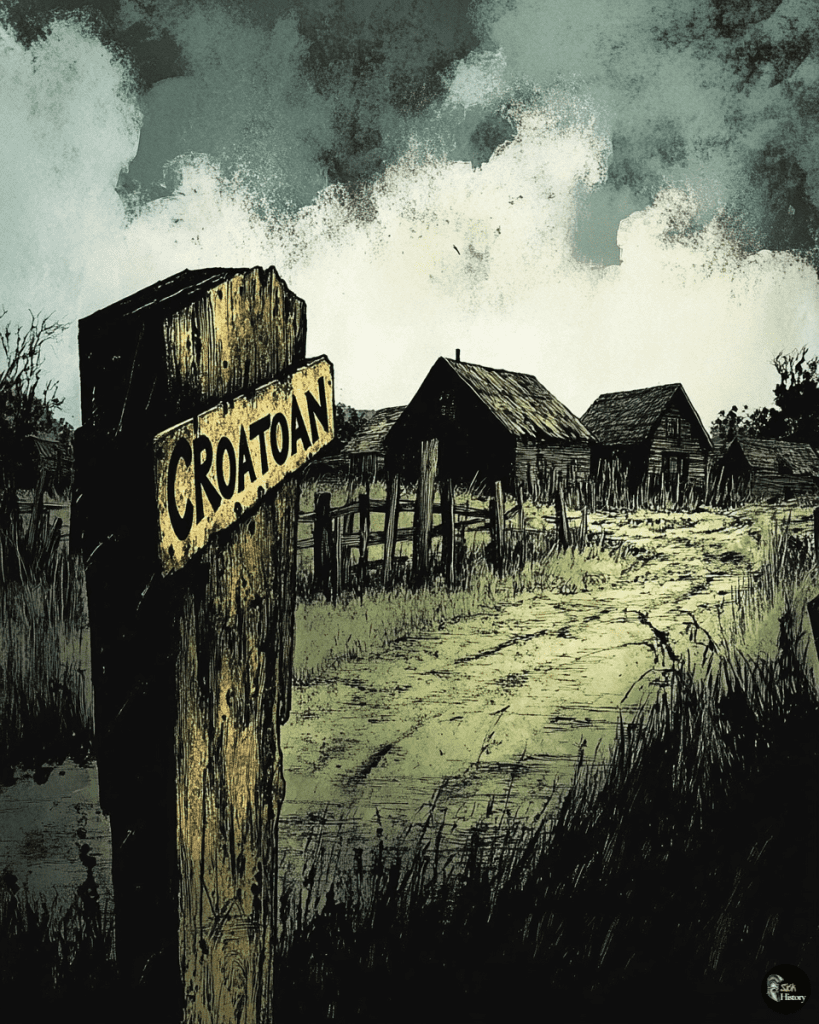The Lost Colony of Roanoke remains one of America’s most enduring mysteries.
In 1587, a group of English settlers established a colony on Roanoke Island, off the coast of what is now North Carolina. Among them was Virginia Dare, the first English child born in the New World.
John White, the colony’s governor, sailed back to England for supplies but his return was delayed by war.
When White finally returned in 1590, he found the settlement abandoned.
The only clues were the words “CROATOAN” carved into a fort post and “CRO” etched on a tree, leading to centuries of speculation about the colonists’ fate.
This disappearance has captivated historians, archaeologists, and the public for over 400 years, spawning numerous theories and investigations.
The Roanoke mystery touches on broader themes of early American colonization, relations with Native Americans, and the challenges faced by Elizabethan settlements.
The story of Roanoke continues to fascinate, offering a compelling glimpse into the perils and promises of early colonial America.
The Enigma of Roanoke
The disappearance of the Roanoke colony remains one of America’s most baffling mysteries.
This enigma has captivated historians, archaeologists, and the public for centuries, spawning numerous theories and investigations.
The Disappearance of the 1590 Colony
In 1587, John White led a group of 115 English settlers to establish a colony on Roanoke Island. White returned to England for supplies, but his journey back was postponed by war with Spain.
When he finally returned in 1590, he found the settlement abandoned.
The only clues left behind were the words “CROATOAN” carved into a fence post and “CRO” on a tree. These cryptic messages have puzzled researchers for generations.
Some theories suggest the colonists integrated with local Native American tribes, while others propose they fell victim to disease or violence.
Recent archaeological discoveries have shed new light on the mystery.
Excavations have unearthed evidence of European artifacts at sites away from the original settlement, hinting at possible relocation.
Investigations into Colonial Archaeology
Archaeological efforts to unravel the Roanoke mystery have intensified in recent decades.
Excavations on Roanoke Island and surrounding areas have yielded intriguing finds, including pottery shards, weaponry, and personal items dating to the late 16th century.
One significant discovery was made at Hatteras Island, corresponding to the location of “Croatoan” mentioned in the carved message.
Here, researchers found a signet ring possibly belonging to one of the colonists, along with other European artifacts mixed with Native American materials.
These findings suggest a potential integration between the colonists and local tribes. However, the evidence remains inconclusive, and the full story of the colonists’ fate continues to elude researchers.
Native American Relations and Impact
The relationship between the Roanoke colonists and local Native American tribes played a crucial role in the settlement’s history.
Initially, interactions were mostly peaceful, with the native Croatoan and Secotan people assisting the newcomers.
However, tensions arose as resources became strained and cultural misunderstandings escalated.
Some historians believe that deteriorating relations may have contributed to the colony’s disappearance.
The impact of European arrival on native populations was profound. Disease, conflict, and cultural disruption reshaped the region’s demographic landscape.
The mystery of Roanoke serves as a poignant reminder of the complex and often tragic interactions between European colonists and Native Americans during this pivotal period in North American history.
Legacies and Cultural Insights
The Lost Colony of Roanoke left an indelible mark on American history and culture. Its mysterious disappearance sparked centuries of fascination, research, and speculation, influencing art, literature, and archaeological pursuits.
Virginia Dare and the Elizabethan Settlement
Virginia Dare, the first English child born in the Americas, symbolized early colonial aspirations.
Her birth on August 18, 1587, represented hope for the Roanoke Island settlers. Virginia Dare’s legacy endured despite her uncertain fate, inspiring countless stories and legends.
The Elizabethan settlement at Roanoke highlighted the challenges faced by early colonists.
Their struggles with unfamiliar environments, limited resources, and complex Native American relations provided valuable lessons for future colonial endeavors.
Roanoke’s disappearance also sparked debates about English colonial strategies and the importance of sustained support for overseas settlements.
Significance of the Dare Stones
The Dare Stones, discovered in the 1930s, added intrigue to the Roanoke mystery.
These engraved rocks purportedly told the story of the colonists’ fate, including mentions of Virginia Dare and her father Ananias.
While most scholars now consider the stones forgeries, they demonstrate the public’s enduring fascination with the Lost Colony.
The stones sparked heated debates among historians and archaeologists, highlighting the challenges of verifying historical claims.
Their controversy also underscored the importance of rigorous authentication processes in historical research and the potential pitfalls of sensationalism in archaeology.

